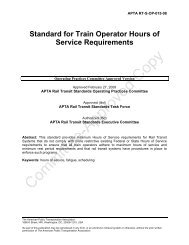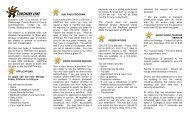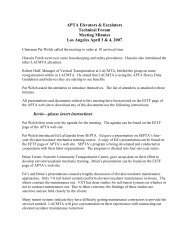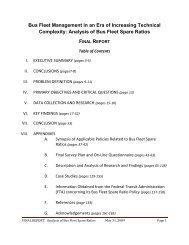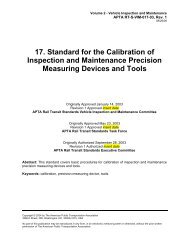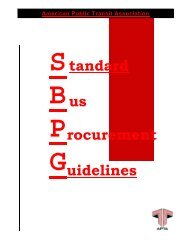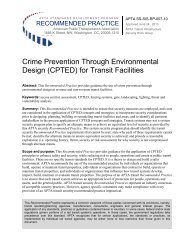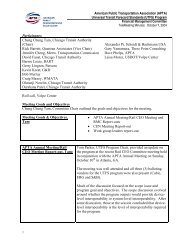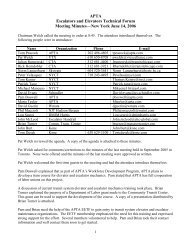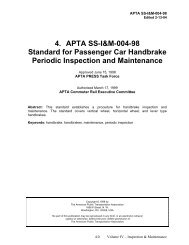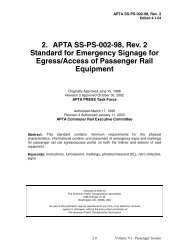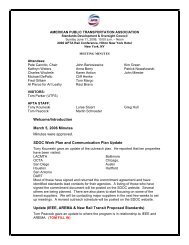Standard for Rail Transit Grade Crossing Warning Systems for Rail ...
Standard for Rail Transit Grade Crossing Warning Systems for Rail ...
Standard for Rail Transit Grade Crossing Warning Systems for Rail ...
You also want an ePaper? Increase the reach of your titles
YUMPU automatically turns print PDFs into web optimized ePapers that Google loves.
Copyright © 2004 by The American Public Transportation Association<br />
1666 K Street, NW, Washington, DC, 20006-1215, USA<br />
Volume 3 - <strong>Rail</strong> <strong>Grade</strong> <strong>Crossing</strong>s Rev. 1<br />
APTA RT-S-RGC-004-03<br />
12/08/05<br />
4. <strong>Standard</strong> <strong>for</strong> <strong>Rail</strong> <strong>Transit</strong> <strong>Grade</strong><br />
<strong>Crossing</strong> <strong>Warning</strong> System Design<br />
Criteria, Installation and Operation<br />
Revision Approved February 7, 2007<br />
Revision Approved December 8, 2005<br />
Approved October 8, 2002<br />
APTA <strong>Rail</strong> <strong>Transit</strong> <strong>Standard</strong>s <strong>Rail</strong> <strong>Grade</strong> <strong>Crossing</strong>s Committee<br />
Revision Approved March 19, 2005<br />
Approved January 10, 2003<br />
APTA <strong>Rail</strong> <strong>Transit</strong> <strong>Standard</strong>s Task Force<br />
Authorized June 8, 2003<br />
APTA <strong>Rail</strong> <strong>Transit</strong> <strong>Standard</strong>s Policy Committee<br />
Abstract: This document provides guidance <strong>for</strong> rail transit systems <strong>for</strong> selecting, installing and<br />
operating highway rail transit grade crossing warning systems and includes minimum<br />
requirements <strong>for</strong> highway rail grade crossing warning devices, highway traffic signs and other<br />
highway traffic control appliances.<br />
Keywords: active warning system, highway grade crossing, highway traffic sign, passive rail<br />
grade crossings, traffic control appliances, warning system<br />
No part of this publication may be reproduced in any <strong>for</strong>m, in an electronic retrieval system or otherwise, without the prior written<br />
permission of The American Public Transportation Association.
Introduction<br />
Volume 3 - <strong>Rail</strong> <strong>Grade</strong> <strong>Crossing</strong>s Rev. 1<br />
APTA RT-S-RGC-004-03<br />
12/08/05<br />
(This introduction is not a part of APTA RT-S-SC-004-02, <strong>Standard</strong> <strong>for</strong> <strong>Rail</strong> <strong>Transit</strong> <strong>Grade</strong> <strong>Crossing</strong> <strong>Warning</strong><br />
System Design Criteria, Installation and Operation.)<br />
APTA rail transit safety standards represent an industry consensus on safety practices <strong>for</strong> rail transit<br />
systems to help achieve a high level of safety <strong>for</strong> passengers, employees, and the general public. This<br />
document was created by and <strong>for</strong> those parties concerned with its provisions; namely, rail transit systems<br />
(operating agencies), manufacturers, consultants, engineers, and general interest groups. This standard<br />
provides design criteria and procedures <strong>for</strong> installing and operating rail transit grade crossing warning<br />
systems.<br />
APTA recommends this standard <strong>for</strong>:<br />
– Individuals or organizations that inspect, maintain, and/or operate rail transit systems<br />
– Individuals or organizations that contract with others <strong>for</strong> the inspection, maintenance, and/or<br />
operation of rail transit systems<br />
– Individuals or organizations that influence how rail transit systems are inspected, maintained,<br />
and/or operated (including but not limited to consultants, designers, and contractors)<br />
This standard intends to meet the following objectives:<br />
– To ensure special life/safety equipment is operational and reliable<br />
– To help rail transit systems incorporate safety considerations during the inspection and<br />
maintenance process<br />
– To identify inspection criteria and maintenance standards that provide a high level of passenger<br />
and personnel safety<br />
The application of any standards, practices, or guidelines contained herein is voluntary. In some cases,<br />
federal and/or state regulations govern portions of how a rail transit system operates. In such cases, the<br />
government regulations override any conflicting practices this document requires or recommends.<br />
Copyright © 2004 APTA. All rights reserved. 4.ii
Participants<br />
Volume 3 - <strong>Rail</strong> <strong>Grade</strong> <strong>Crossing</strong>s Rev. 1<br />
APTA RT-S-RGC-004-03<br />
12/08/05<br />
APTA greatly appreciates the contributions of the following members of the <strong>Rail</strong> <strong>Transit</strong> <strong>Standard</strong>s <strong>Rail</strong> <strong>Grade</strong><br />
<strong>Crossing</strong>s Committee who provided the primary ef<strong>for</strong>t in drafting the <strong>Standard</strong> <strong>for</strong> <strong>Rail</strong> <strong>Transit</strong> <strong>Grade</strong><br />
<strong>Crossing</strong> <strong>Warning</strong> System Design Criteria, Installation and Operation:<br />
Nicholas Bahr<br />
Robert Banks<br />
Bill Browder<br />
Richard Brown<br />
Terry Byrne<br />
Richard Campbell<br />
Steven Carroll<br />
K.C. Cooper<br />
Rhonda Crawley<br />
Charles “Ty” Dickerson<br />
Daniel Foth<br />
Susan Gilbert<br />
Brian Gilleran<br />
Robert Glass<br />
Alex Goff<br />
Robert Banks, Chair<br />
Ali Gord<br />
Vernon Hartsock<br />
Ken Kobetsky<br />
Hans Korve<br />
Quon Kwan<br />
Robert Lauby<br />
Chuck Maples<br />
Michael McArdle<br />
Harry McCall<br />
Linda Meadow<br />
John Mitchell<br />
Paul O’Brien<br />
Phil Olekszyk<br />
Lorraine Pacocha<br />
William Petit<br />
Albert Powell<br />
Linda Rhodes<br />
Mark Robinson<br />
Harry Saporta<br />
John Sharkey<br />
Ronald Swindell<br />
Naor Wallach<br />
Jack Webb<br />
Terrell Williams<br />
Robert Winans<br />
Thomas Woll<br />
Vanessa Young<br />
Abdul Zohbi<br />
The following members of the <strong>Rail</strong> <strong>Transit</strong> <strong>Standard</strong>s <strong>Rail</strong> <strong>Grade</strong> <strong>Crossing</strong>s Committee contributed to the<br />
review and approval process of the: <strong>Standard</strong> <strong>for</strong> <strong>Rail</strong> <strong>Transit</strong> <strong>Grade</strong> <strong>Crossing</strong> <strong>Warning</strong> System Design<br />
Criteria, Installation and Operation:<br />
Robert Banks<br />
Richard Brown<br />
Lynda Bybee<br />
Terry Byrne<br />
Richard Campbell<br />
Daniel Carrizales<br />
Steven Carroll<br />
Debra Chappell<br />
Brian Clark<br />
K.C. Cooper<br />
Rhonda Crawley<br />
Terrence Culhane<br />
Jack Dickens<br />
Charles “Ty” Dickerson<br />
Manuel Galdo<br />
Nocole Gamache<br />
Wende Gannon<br />
Chuck Gibson<br />
Ronald O. Swindell, Chair<br />
Abdul Zohbi, Vice Chair<br />
Susan Gilbert<br />
Brian Gilleran<br />
Alex Goff<br />
Jack Graham<br />
Allison Grissom<br />
Greg Hackbarth<br />
Gerri Hall<br />
Vernon Hartsock<br />
Miriam Kloeppel<br />
Hans Korve<br />
Quon Kwan<br />
John Lech<br />
David Lozeau<br />
Chuck Maples<br />
Michael McArdle<br />
Harry McCall<br />
Linda Meadow<br />
John Mitchell<br />
Paul O’Brien<br />
Lorraine Pacocha<br />
William Petit<br />
Jeffrey Power<br />
Linda Rhodes<br />
Mark Robinson<br />
Harry Saporta<br />
Paul Schneider<br />
John Sharkey<br />
Michael Small<br />
Fred Small<br />
James Stem<br />
Naor Wallach<br />
Jack Webb<br />
Terrell Williams<br />
Robert Winans<br />
Vanessa Young<br />
APTA <strong>Rail</strong> <strong>Transit</strong> <strong>Standard</strong>s <strong>Rail</strong> <strong>Grade</strong> <strong>Crossing</strong> Inspection and Maintenance Committee project consultant:<br />
APTA <strong>Rail</strong> <strong>Transit</strong> <strong>Standard</strong>s project team:<br />
Phil Olekszyk, World Wide <strong>Rail</strong>, Inc.<br />
Maria Taylor, Program Manager-Technical Services<br />
Saahir Brewington, Program Manager-<strong>Standard</strong>s<br />
Thomas Peacock, Director-Operations & Technical Services<br />
Copyright © 2004 APTA. All rights reserved. 4.iii
Contents<br />
Volume 3 - <strong>Rail</strong> <strong>Grade</strong> <strong>Crossing</strong>s Rev. 1<br />
APTA RT-S-RGC-004-03<br />
12/08/05<br />
1. Overview................................................................................................................................................4.1<br />
1.1 Scope ...............................................................................................................................................4.1<br />
1.2 Purpose ............................................................................................................................................4.1<br />
1.3 Application ......................................................................................................................................4.1<br />
1.4 Alternate practices ...........................................................................................................................4.1<br />
2. References..............................................................................................................................................4.2<br />
3. Definitions and acronyms ......................................................................................................................4.4<br />
3.1 Definitions .......................................................................................................................................4.4<br />
3.2 Acronyms.........................................................................................................................................4.5<br />
4. Functional/operating guidelines.............................................................................................................4.5<br />
4.1 Highway rail crossing warning systems ..........................................................................................4.5<br />
4.1.1 <strong>Warning</strong> time ............................................................................................................4.6<br />
4.1.2 Near-side station stops..............................................................................................4.6<br />
4.1.3 Audible warning devices ..........................................................................................4.6<br />
4.1.4 Interconnection circuits ............................................................................................4.6<br />
4.1.5 Adjacent track interconnected systems.....................................................................4.7<br />
4.1.6 Motion sensitive systems..........................................................................................4.7<br />
4.1.7 Constant warning time devices.................................................................................4.7<br />
4.2 Monitoring devices......................................................................................................4.7<br />
4.2.1 Solid-state warning device controllers .....................................................................4.7<br />
4.2.2 Track circuits ............................................................................................................4.7<br />
4.2.3 Wayside-based train detection systems ....................................................................4.7<br />
4.2.4 Processor-Based <strong>Systems</strong> .........................................................................................4.7<br />
4.2.5 Highway rail crossing traffic control devices...........................................................4.7<br />
Annex A.....................................................................................................................................................4.9<br />
(In<strong>for</strong>mative)..............................................................................................................................................4.9<br />
Bibliography ..............................................................................................................................................4.9<br />
Copyright © 2004 APTA. All rights reserved. 4.iv
Volume 3 - <strong>Rail</strong> <strong>Grade</strong> <strong>Crossing</strong>s Rev. 1<br />
APTA RT-S-RGC-004-03<br />
12/08/05<br />
<strong>Standard</strong> <strong>for</strong> <strong>Rail</strong> <strong>Transit</strong> <strong>Grade</strong> <strong>Crossing</strong> <strong>Warning</strong><br />
System Design Criteria, Installation and Operation<br />
1. Overview<br />
This standard prescribes minimum requirements <strong>for</strong> the design, procurement, installation, and<br />
implementation of highway rail gated grade crossing systems within rail transit systems and<br />
includes requirements <strong>for</strong> train detection, gate operation, lights, bells, highway traffic signs,<br />
signals, and pavement markings.<br />
1.1 Scope<br />
This standard applies to rail transit systems that operate and maintain highway rail grade crossing<br />
systems.<br />
1.2 Purpose<br />
The purpose of this standard is to verify highway rail grade crossing devices and systems are<br />
operating safely and as designed through periodic testing, thereby increasing reliability and<br />
reducing the risk of hazards and failures.<br />
1.3 Application<br />
APTA member rail transit systems shall adopt this standard and meet or exceed it within 5 years<br />
from the date of publication. For major modifications, a plan shall be developed within 5 years<br />
to bring the rail transit system (RTS) into compliance with this standard.<br />
1.4 Alternate practices<br />
Individual rail transit systems may modify the practices in this standard to accommodate their<br />
specific equipment and mode of operation. APTA recognizes that some rail transit systems may<br />
have unique operating environments that make strict compliance with every provision of this<br />
standard impractical. As a result, certain rail transit systems may need to implement the<br />
standards and practices herein in ways that are more or less restrictive than this document<br />
prescribes. A rail transit system (RTS) may develop alternates to the APTA standards so long as<br />
the alternates are based on a safe operating history and are described and documented in the<br />
system’s safety program plan (or another document that is referenced in the system safety<br />
program plan).<br />
Documentation of alternate practices shall:<br />
a) Identify the specific APTA rail transit safety standard requirements that cannot be met<br />
Copyright © 2004 APTA. All rights reserved. 4.1
) State why each of these requirements cannot be met<br />
c) Describe the alternate methods used<br />
Volume 3 - <strong>Rail</strong> <strong>Grade</strong> <strong>Crossing</strong>s Rev. 1<br />
APTA RT-S-RGC-004-03<br />
12/08/05<br />
d) Describe and substantiate how the alternate methods do not compromise safety and<br />
provide a level of safety equivalent to the practices in the APTA safety standard<br />
(operating histories or hazard analysis findings may be used to substantiate this claim).<br />
2. References<br />
This standard shall be used in conjunction with the latest version of the following publications.<br />
In the event that a conflict between this standard and a referenced document exists, this standard<br />
shall take precedence, to the extent not preempted by law. Provisions of the referenced<br />
documents not in conflict with this standard, shall apply as referenced herein.<br />
23 CFR 665, Highways, Subpart F, Traffic Control Devices on Federal-Aid and Other Streets<br />
and Highways, 2002.<br />
AREMA Signal Manual, Part 1.4.1, Identical Items "Boilerplate <strong>for</strong> All Manual Parts.”<br />
AREMA Signal Manual, Section 3, Highway <strong>Rail</strong> <strong>Grade</strong> <strong>Crossing</strong> <strong>Warning</strong> <strong>Systems</strong>.<br />
AREMA Signal Manual, Part 3.1.10.<br />
AREMA Signal Manual, Part 3.1.11.<br />
AREMA Signal Manual, Part 3.1.15, E.8, Recommended Functional/Operating Guidelines <strong>for</strong><br />
Control of Automatic Highway <strong>Rail</strong> <strong>Grade</strong> <strong>Crossing</strong> <strong>Warning</strong> <strong>Systems</strong>.<br />
AREMA Signal Manual, Part 3.1.16,<br />
AREMA Signal Manual, Part 3.1.25, Recommended Design Criteria and Functional Guidelines<br />
<strong>for</strong> Solid-State Highway rail <strong>Grade</strong> <strong>Crossing</strong> <strong>Warning</strong> Device Controllers.<br />
AREMA Signal Manual, Part 3.1.29.<br />
AREMA Signal Manual, Part 3.2.60.<br />
AREMA Signal Manual, Part 3.2.61.<br />
AREMA Signal Manual, Section 8.<br />
AREMA Signal Manual, Part 11.2.1, Recommended General Practices <strong>for</strong> Electrical Surge<br />
Protection <strong>for</strong> Signal <strong>Systems</strong>.<br />
AREMA Signal Manual, Part 11.3.3, Recommended Design Criteria <strong>for</strong> Surge Withstand<br />
Capability of Electronic Signal Equipment <strong>for</strong> Signal <strong>Systems</strong>.<br />
AREMA Signal Manual, Part 11.5.1, Recommended Environmental Requirements <strong>for</strong> Electrical<br />
and Electronic RTS Signal System Equipment.<br />
Copyright © 2004 APTA. All rights reserved. 4.2
Volume 3 - <strong>Rail</strong> <strong>Grade</strong> <strong>Crossing</strong>s Rev. 1<br />
APTA RT-S-RGC-004-03<br />
12/08/05<br />
AREMA Signal Manual, Part 14.1, Recommended Wire Connectors, Terminals.<br />
AREMA Signal Manual, Part 16.3.2, Recommended Application Design Guidelines <strong>for</strong> Isolation<br />
of Power Supplies used in Vital Signal <strong>Systems</strong>.<br />
AREMA Signal Manual, Part 16.30.10, Recommended Vital Circuit Design Guidelines <strong>for</strong><br />
Highway Traffic Signal Interconnection.<br />
AREMA Signal Manual, Part 17.2.1, Recommended Quality Assurance Program <strong>for</strong><br />
Electronic/Software Based Products Used in Vital Signal Applications.<br />
AREMA Signal Manual, Part 17.3, Safety Assurance of Vital Electronic/Software-Based<br />
Equipment Used in Signal Applications, 2001.<br />
AREMA Signal Manual, Part 17.3.1, Recommended Safety Assurance Program <strong>for</strong> Vital<br />
Electronic/Software-Based Equipment and <strong>Systems</strong> Used in Signal Applications.<br />
AREMA Signal Manual, Part 17.4.1, Recommended Reliability and Maintainability Assurance<br />
Program <strong>for</strong> Vital Electronic/Software-Based Equipment and <strong>Systems</strong> Used in Signal<br />
Applications.<br />
AREMA Signal Manual, Part 17.5.1, Recommended Configuration Management Program <strong>for</strong><br />
Vital Electronic/Software-Based Equipment and <strong>Systems</strong> Used in Signal Applications.<br />
Federal Register “<strong>Standard</strong>s <strong>for</strong> Development and Use of Processor-Based Signal and Train<br />
Control <strong>Systems</strong>; Proposed Rule,” August 10, 2001.<br />
IEEE Std. 100-1996, IEEE <strong>Standard</strong> Dictionary of Electrical and Electronic Terms, Sixth<br />
Edition.<br />
IEEE Std. 1483-2000, IEEE <strong>Standard</strong> <strong>for</strong> Verification of Vital Functions in Processor-Based<br />
<strong>Systems</strong> Used in <strong>Rail</strong> <strong>Transit</strong> Control.<br />
IEEE Std. 1570-2002, <strong>Standard</strong> <strong>for</strong> the Interface between the <strong>Rail</strong> Subsystem and the Highway<br />
Subsystem at a Highway <strong>Rail</strong> Intersection.<br />
Institute of Transportation Engineers Recommended Practice <strong>for</strong> “Preemption of Traffic Signals<br />
Near <strong>Rail</strong>road <strong>Grade</strong> <strong>Crossing</strong>s-2004.<br />
MUTCD, Section 1.A.10, Manual of Uni<strong>for</strong>m Traffic Control Devices, General Provisions,<br />
Interpretations, Experiments and Changes<br />
The above standards are available from the following sources:<br />
AREMA Signal Manual<br />
http://www.arema.org/pubs/pubs.htm<br />
FHWA Manual on Uni<strong>for</strong>m Traffic Control Devices<br />
Copyright © 2004 APTA. All rights reserved. 4.3
http://mutcd.fhwa.dot.gov/kno-millennium.htm<br />
IEEE <strong>Standard</strong>s<br />
http://standards.ieee.org/faqs/order.html<br />
3. Definitions and acronyms<br />
Volume 3 - <strong>Rail</strong> <strong>Grade</strong> <strong>Crossing</strong>s Rev. 1<br />
APTA RT-S-RGC-004-03<br />
12/08/05<br />
For the purposes of this standard, the following definitions and acronyms apply. IEEE Std 100-<br />
1996 1 and the AREMA Signal Manual should be referenced <strong>for</strong> terms not defined in this clause.<br />
3.1 Definitions<br />
3.1.1 fail-safe: A design philosophy applied to safety critical systems that prohibits hardware<br />
failures or software errors from causing a system to assume or maintain an unsafe state.<br />
3.1.2 gate up: A crossing gate is in the “up” or raised position when it is vertical in accordance<br />
with the pre-determined design from horizontal (typically 85 to 92 degrees depending on specific<br />
gate mechanism adjustment and other factors.)<br />
3.1.3 highway: A public way <strong>for</strong> purposes of travel, including the entire area within the rightof-way.<br />
Syn: road, street.<br />
3.1.4 highway-rail grade crossing: (A) A location where a public highway, road, street, or<br />
private roadway, including associated sidewalks and pathways, crosses one or more railroad<br />
track at grade. (B) The general area where a highway and a railroad’s right of way cross at the<br />
same level, within which are included the railroad tracks, highway, and traffic control devices <strong>for</strong><br />
highway traffic traversing that area.<br />
3.1.5 interconnection: The electrical connection between the railroad active warning system<br />
and the traffic signal controller assembly <strong>for</strong> the purpose of preemption.<br />
3.1.6 island: The portion of the highway rail grade crossing where the highway and/or<br />
pedestrian walkways directly cross the railroad tracks.<br />
3.1.7 median: The area between two roadways of a divided highway measured from edge of<br />
traveled way to edge of traveled way, excluding turn lanes. The median width may be different<br />
between intersections, interchanges, and opposite approaches of the same intersection.<br />
3.1.8 near side station stop: A station stop within the approach limits of a highway rail grade<br />
crossing.<br />
3.1.9 original equipment manufacturer (OEM): The enterprise that initially designs and<br />
builds a piece of equipment.<br />
3.1.10 preemption: The transfer of normal operation of traffic signals to a special control mode<br />
that interrupts the normal sequence of traffic signal phases to accommodate train operation at, or<br />
adjacent to, the traffic signal controlled intersection.<br />
1 For references in italic, see Section 2.<br />
Copyright © 2004 APTA. All rights reserved. 4.4
Volume 3 - <strong>Rail</strong> <strong>Grade</strong> <strong>Crossing</strong>s Rev. 1<br />
APTA RT-S-RGC-004-03<br />
12/08/05<br />
3.1.11 priority: Signal priority modifies the normal highway traffic signal operation process to<br />
better accommodate train operation at or adjacent to the traffic signal controlled intersection.<br />
3.1.12 rail transit system (RTS): The organization or portion of an organization that operates<br />
rail transit service and related activities. Syn: operating agency, operating authority, transit<br />
agency, transit authority, transit system.<br />
3.1.13 rail transit: All <strong>for</strong>ms of non-highway ground transportation that operate on rail<br />
including light rail, streetcars, trolley, and rapid rail transit systems.<br />
3.1.14 safe: Having acceptable risk of the occurrence of a hazard.<br />
3.1.15 safety assurance: A characteristic of system implementation that assures a level of safe<br />
operation.<br />
3.1.16 safety critical: A term applied to a system or function <strong>for</strong> which correct per<strong>for</strong>mance is<br />
critical to the safety of personnel and/or equipment or a system or function <strong>for</strong> which incorrect<br />
per<strong>for</strong>mance may result in an unacceptable risk of a hazard. See: fail-safe.<br />
NOTE-Such a designation may require the incorporation of additional special safety design features.<br />
3.1.17 safety: Freedom from those conditions that can cause death, injury, or occupational<br />
illness, damage to the environment, or damage to or loss of equipment or property.<br />
3.1.18 vital function: A safety critical function that requires fail-safe implementation. See: failsafe,<br />
safety critical.<br />
NOTE-Vital functions are a subset of safety-critical functions.<br />
3.2 Acronyms<br />
APTA American Public Transportation Association<br />
AREMA American <strong>Rail</strong>way Engineering and Maintenance-of-Way Association<br />
ATCS automated train control system<br />
CFR Code of Federal Regulations<br />
EIA Electronic Industries Association<br />
IEEE Institute of Electrical and Electronics Engineers<br />
MUTCD Manual on Uni<strong>for</strong>m Traffic Control Devices<br />
OEM original equipment manufacturer<br />
RF radio frequency<br />
RTS rail transit system<br />
RTV rail transit vehicles<br />
4. Functional/operating guidelines<br />
4.1 Highway rail crossing warning systems<br />
Highway rail grade crossing warning systems shall con<strong>for</strong>m to AREMA Signal Manual, Part<br />
3.1.15 which discusses general requirements, controls <strong>for</strong> highway-rail grade crossing warning<br />
Copyright © 2004 APTA. All rights reserved. 4.5
systems and two (2) and four (4) quadrant gate systems..<br />
4.1.1 <strong>Warning</strong> time<br />
Volume 3 - <strong>Rail</strong> <strong>Grade</strong> <strong>Crossing</strong>s Rev. 1<br />
APTA RT-S-RGC-004-03<br />
12/08/05<br />
Highway rail grade crossing warning systems shall be maintained to operate in compliance with<br />
the design of the warning system, but in no event shall they provide less than 20 seconds warning<br />
time <strong>for</strong> the operation of through trains be<strong>for</strong>e grade crossings are occupied by rail traffic.<br />
Alternative warning times may be authorized by the RTS <strong>for</strong> special conditions such as near-side<br />
station stops. For these conditions, the train operator shall be able to stop the train prior to<br />
entering the intersection until it is verified that the warning system is active, and if so equipped,<br />
gates are in the fully horizontal position, and that the intersection is clear of highway and/or<br />
pedestrian traffic.<br />
4.1.2 Near-side station stops<br />
Operation of grade crossing warning systems may be delayed or bypassed <strong>for</strong> near-side station<br />
stops under any of the following conditions:<br />
a) <strong>Transit</strong> Authority operating rules require that all trains (or other vehicles normally<br />
causing the warning system to operate) shall stop at the station. This includes stopping<br />
<strong>for</strong> the minimum dwell time if so designed, OR;<br />
b) Vital functions are used to identify trains that must stop at the station by operating rule,<br />
OR;<br />
c) For locations equipped with crossing gates, vital functions (implemented by a signal or<br />
train control system) shall provide a warning and/or prevent the train from entering the<br />
crossing until the gates are down.<br />
Where electronic or processor-based systems are used, they shall con<strong>for</strong>m to AREMA Signal<br />
Manual, Part 17.3 and/or IEEE Std. 1483-2000.<br />
Where near side station stops are adjacent to interconnected traffic signal controlled<br />
intersections, accommodations must be made to ensure adequate pedestrian and vehicle<br />
clearance intervals.<br />
4.1.3 Audible warning devices<br />
Each active crossing warning system shall be equipped with no less than one (1) crossing bell or<br />
other audible warning system in compliance with state requirements. Each bell shall con<strong>for</strong>m to<br />
AREMA Signal Manual 3.1.15.E.8, 3.2.60 & 61. Additional ancillary audible devices may be<br />
used at the rail transit system’s discretion.<br />
4.1.4 Interconnection circuits<br />
Interconnection circuits between highway traffic signals and highway rail grade crossing<br />
warning systems shall con<strong>for</strong>m to AREMA Signal Manual Part 3.1.10. and Part 16.30.10. Serial<br />
communication interconnects shall also con<strong>for</strong>m to IEEE Std. 1570-2002.<br />
Copyright © 2004 APTA. All rights reserved. 4.6
4.1.5 Adjacent track interconnected systems<br />
Volume 3 - <strong>Rail</strong> <strong>Grade</strong> <strong>Crossing</strong>s Rev. 1<br />
APTA RT-S-RGC-004-03<br />
12/08/05<br />
Adjacent track interconnected highway rail grade crossing warning systems shall con<strong>for</strong>m to<br />
AREMA Signal Manual Part 3.1.11.<br />
4.1.6 Motion sensitive systems<br />
Motion sensitive systems that control highway rail grade crossing warning systems shall con<strong>for</strong>m<br />
to AREMA Signal Manual Part 3.1.25.<br />
4.1.7 Constant warning time devices<br />
Constant warning time devices that control highway rail grade crossing warning systems shall<br />
con<strong>for</strong>m to AREMA Signal Manual Part 3.1.26.<br />
4.2 Monitoring devices<br />
Monitoring devices <strong>for</strong> highway rail grade crossing warning systems shall con<strong>for</strong>m to AREMA<br />
Signal Manual Part 3.1.29.<br />
4.2.1 Solid-state warning device controllers<br />
Solid-state highway rail grade crossing warning device controllers shall con<strong>for</strong>m to AREMA<br />
Signal Manual Part 3.1.25.<br />
4.2.2 Track circuits<br />
Track circuits shall con<strong>for</strong>m to AREMA Signal Manual, Section 8.<br />
4.2.3 Wayside-based train detection systems<br />
Wayside based train detection systems (not based on track circuits) used to activate highway rail<br />
grade crossing warning devices shall be in con<strong>for</strong>mance with AREMA Signal Manual Part<br />
3.1.16.<br />
4.2.4 Processor-Based <strong>Systems</strong><br />
Where new or novel technology is being used with processor-based systems, or where highwayrail<br />
grade crossing equipment provides safety-critical data to a signal or train control system, rail<br />
transit properties should consider guidance provided by 49 CFR 234.275. New or novel<br />
technology refers to a technology not previously recognized <strong>for</strong> use in commercial service as of<br />
March 7, 2005 and includes such technology as that incorporated in new designs which do not<br />
use conventional track circuits.<br />
4.2.5 Highway rail crossing traffic control devices<br />
Highway traffic control devices shall be in compliance with the Manual of Uni<strong>for</strong>m Traffic<br />
Control Devices (MUTCD).<br />
Deviations from MUTCD shall be in compliance with MUTCD, Section 1.A.10.<br />
Copyright © 2004 APTA. All rights reserved. 4.7
4.2.5.1 Preemption or priority at traffic signal controlled intersections<br />
Volume 3 - <strong>Rail</strong> <strong>Grade</strong> <strong>Crossing</strong>s Rev. 1<br />
APTA RT-S-RGC-004-03<br />
12/08/05<br />
<strong>Rail</strong> transit vehicles may operate along or across streets that are part of a coordinated traffic<br />
signal system at speeds consistent with line of sight operation. In these settings, the rail transit<br />
vehicles (RTV) priority or preemption should take place within the overall background cycle.<br />
The goal of traffic signal priority should be to minimize the delay <strong>for</strong> rail transit vehicles.<br />
Additionally these strategies should balance (1) the maintenance of parallel and cross-street<br />
progressions and other traffic requirements, (2) the provision of safe clearances <strong>for</strong> errant motor<br />
vehicles and pedestrians, and (3) a minimal delay of preempted motor vehicle or pedestrian<br />
movements.<br />
In<strong>for</strong>mation regarding the application of preemption at traffic signal controlled intersections can<br />
be found in the Institute of Transportation Engineers Recommended Practice <strong>for</strong>, “Preemption<br />
of Traffic Signals Near <strong>Rail</strong>road <strong>Grade</strong> <strong>Crossing</strong>s –2004..”<br />
The rail transit system shall coordinate preemption with the local authority having jurisdiction<br />
over traffic signal operation.<br />
4.2.5.2 Preemption of interconnected traffic signal controlled intersections<br />
Preemption may be used to clear highway vehicles and pedestrians from the trackway during the<br />
time the crossing warning system is activated, prior to the RTV entering the crossing.<br />
Where near side station stops are adjacent to interconnected traffic signal controlled<br />
intersections, accommodations shall be made to ensure adequate pedestrian and vehicle clearance<br />
intervals.<br />
4.2.5.3 Medians<br />
Medians are an effective treatment to reduce violations of gated highway rail crossing warning<br />
systems. Where analysis indicates and roadway geometry permits, a median should separate<br />
traffic lanes. Roadway geometry or left turn requirements may require application of a shortened<br />
median or raised delineators to separate traffic lanes.<br />
Dimensions and location of medians should be in compliance with local requirements.<br />
Copyright © 2004 APTA. All rights reserved. 4.8
Annex A<br />
(In<strong>for</strong>mative)<br />
Bibliography<br />
[B1] 49 CFR 234, Subpart D, <strong>Grade</strong> <strong>Crossing</strong> Signal Safety,<br />
http://www.fra.dot.gov/counsel/regs/cfr_49_oct1998/index.htm<br />
Volume 3 - <strong>Rail</strong> <strong>Grade</strong> <strong>Crossing</strong>s Rev. 1<br />
APTA RT-S-RGC-004-03<br />
12/08/05<br />
Copyright © 2004 APTA. All rights reserved. 4.9



